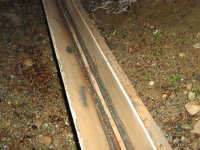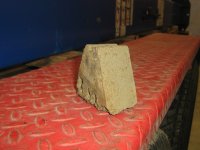bigtiller
Super Member
- Joined
- Feb 1, 2006
- Messages
- 7,239
- Location
- central Iowa
- Tractor
- John Deere 2720 John Deere 3039R John Deere Z545R
No inspection on a garage floor here so I was on my own. I installed foam over the compacted base, then plastic before installing the rebar. Rather than 12"x12" squares, I used 10"x14" because it would be easier for my big feet. My concrete contractor warned me that plastic rebar chairs would sink into the foam, destroying all my hard work so I made my own out of concrete. They were a pyramid with a 2"x3" base,1 1/2" high, spaced evenly, using about 400 of them in an area of 1360 square feet. I installed the pex above the bar because it was too difficult to put it below. It was easy to walk around before the concrete was poured because of the size of the squares and then when the workers couldn't see the bar anymore, they would occasionally stumble but it didn't damage anything while they walked on top of the bar. This did require using a pump.
What did you use for forms to make your own rebar chairs? Did you mix your own concrete or buy pre mixed?



